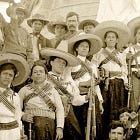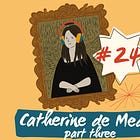Hey everyone,
What a weekend it’s been here in LA. I’m not sure what’s going on, but some people who preordered my new book through Bookshop received their copies 10 days early! I have loved seeing it in people’s hands already. If you have your copy, let me know!
Also, as a side note… I can’t believe that I have done 50 of these history roundups! That is a ton of historical news and updates. I am excited to see what we learn about in the next 50!
This week I posted a look at the soldadera to adelita pipeline, so if you haven't checked that out yet, now is a good time!
This week, in history acting unruly in the news…
I love these 15 moving photos to celebrate Black History Month.
The creative collaboration between Kiki de Montparnasse and Man Ray begs the question—who made who, the artist or the subject?
I’m always annoyed by conspiracy theories that extraterrestrials built the pyramids because those theories necessarily discredit the abilities of Ancient Egyptians. It is racist propaganda predicated on the idea that Ancient Egyptians were not intelligent enough to build the pyramids themselves. Which is why I’m delighted to find out that an ancient Egyptian diary written on papyrus has been discovered—and it’s all about how the pyramids were built.

This daily diary written by a government official named Merer documents three months’ worth of work building the Great Pyramid. Source. Speaking of overlooking achievements of people of color—the credit of “first to the North Pole” has long been given to explorer Robert Peary. But a member of Peary’s team got there first, by at least 45 minutes. Why was Mathew Henson’s achievement forgotten? Well, because he was Black.
How the rare great auk of Iceland gave us the concept of extinction.
Speaking of conservation… I wouldn’t say that this is what this article is about, but I find the intersection of Bigfoot believers and nature conservationists really fascinating.
At a time when women are often considered powerless, this brave widow sought justice—and won it—after the French Wars of Religion.
If you want to hear more about the French Wars of Religion, listen to my episode on Catherine de Medici, who oversaw one of the most violent atrocities of the conflicts.
For decades, the famous Tiffany lamps—Art Nouveau masterpieces that routinely fetch thousands at auction—were credited to Louis Comfort Tiffany, the dilettante son of the company’s founders. But the true geniuses behind the beautiful lamps were a group of women and, in particular, an artist named Clara Driscoll.

‘Lotus, Pagoda' lamp, ca. 1900-15, Made in New York, NY, at Tiffany Studios. Leaded Favrile glass and patinated bronze, 31 1/2 in. (80 cm). Although Tiffany Studios is famous for leaded-glass floral motif shades, it also created arresting geometric designs, such as this “Lotus Pagoda” lamp. This particular one—the largest and rarest known example of this design—was owned by an apprentice of Frank Lloyd Wright! (Photo by: Sepia Times/Universal Images Group via Getty Images) The origins of the medieval bestiary are fascinating, and they can show us how humans have always anthropomorphized animals.
And speaking of animals: critics make much of how much Millenials love their pets today, but in a 2,000-year-old cemetery in Verona, some people were buried with their beloved dogs.
Mary Cardwell Dawson put Black musicians front and center in a groundbreaking musical company in the mid-twentieth century.
You know about leap years—don’t forget, it’s their year!—but do you know about leap seconds? Apparently, we’ve been using them since the 1970s to keep astrological time and atomic time, which powers our clocks. But now scientists are posed to abandon the leap second.
This 2,200-year-old stone slab contains our earliest known record of leap year.
The romcom Leap Year is based on a real (but outdated) Irish tradition that dates back to the 5th century CE.
Gerard Butler in 300 may have taught a new generation about the most famous battle at Thermopylae, but the narrow pass in Greece has been the site of several historically important battles.
Historians often (rightly) question ancient Greek historian Herodotus’s fantastical accounts of history, but recent discoveries have confirmed one of his more grisly stories: Ancient Scythians did, in fact, fashion “items from the skins of those they defeated,” as Herodotus claimed. Jury is still out on whether they also drank blood.
Surprise: Spiritualism has a complicated history in the United States!
Britain’s last witch was known as Hellish Nell. She was prosecuted for getting classified military secrets during WWII…from spirits. Among her achievements was knowing a British warship had sunk before high-ranking members of the military did because a dead sailor visited during a seance.
Also, uhm, a physician tried to try to resurrect George Washington after he died? Why wasn’t I taught that in high school? (No, that’s not a typo—he sought permission to try, but the family said no.)

Death of Washington, N. Currier, 1846. Source: Library of Congress. Lately, academics and historians have been uncovering Harriet Tubman’s role in the Civil War: spy against the Confederacy.
The story of how Las Vegas transformed from inhospitable desert to sin city.
How tea funded the British Empire—and kept millions of people oppressed.
We often talk about the architectural successes of Ancient Roman construction. After all, it took until the 20th century for some of their achievements to be repeated! But what about their failures—were they just as colossal as their successes?
Who were the three samurai responsible for unifying Japan? Hint: We’ve covered one’s famous retainer on the podcast!
What do you know about the famous Broadway flop, Moose Murders?
Are we in a golden age of Medieval nostalgia?
Have a wonderful week, everyone!
Don’t forget: My debut book, Unruly Figures: Twenty Tales of Rebels, Rulebreakers, and Revolutionaries comes out on March 5! Preorder now and it’ll arrive in your hands that day.








all of these!!! 💯💯💯